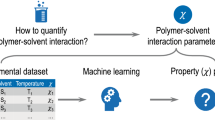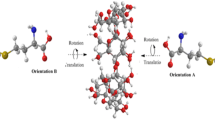Abstract
The atomic-level AI topological indices and the modified Xu (mXu) index were utilized for quantitative structure–property relationship (QSPR) modeling of the infinite dilution activity coefficients of 108 oxo compounds in water at 298.15 K. Stepwise multiple linear regression (SMLR) analysis using the topological descriptors resulted in a model with R2 = \({\mathrm{R}}_{\mathrm{a}\mathrm{d}\mathrm{j}}^{2}\)= 0.9904, SE = 0.3769, F = 1267.1 and an average relative error of 4.89%. The selected descriptors were then used to develop an artificial neural network (ANN) model for the activity coefficients. Findings of the study indicated that a 7–8-1 ANN trained by Levenberg–Marquardt algorithm results in the improved predictions, especially in view of a decrease as large as 47.24% in the average relative error compared to the SMLR model. The AI indices with a total contribution of 81.43% showed the dominant role of the atomic groups of the oxo compounds in determination of their activity coefficients at infinite dilution in water.





Similar content being viewed by others
References
Hsieh, C.M., Lin, S.T.: Prediction of 1-octanol–water partition coefficient and infinite dilution activity coefficient in water from the PR+COSMOSAC model. Fluid Phase Equilib. 285, 8–14 (2009)
Kojima, K., Zhang, S., Hiaki, T.: Measuring methods of infinite dilution activity coefficients and a database for systems including water. Fluid Phase Equilib. 131, 145–179 (1997)
Cheng, J.S., Tang, M., Chen, Y.P.: Correlation of solid solubility for biological compounds in supercritical carbon dioxide: comparative study using solution model and other approaches. Fluid Phase Equilib. 194–197, 483–491 (2002)
Shen, S., Nagata, I.: Prediction of excess enthalpies of ketone–alkane systems from infinite dilution activity coefficients. Themochim. Acta 258, 19–31 (1995)
Morton, D.W., Young, C.L.: Henry's law constants and infinite dilution activity coefficients of C2–C8 hydrocarbons in phenylalkanes. J. Chem. Thermodyn. 28, 895–904 (1996)
Sandler, S.I.: Infinite dilution activity coefficients in chemical, environmental and biochemical engineering. Fluid Phase Equilib. 116, 343–353 (1996)
Lindvig, T., Hestkjær, L.L., Hansen, A.F., Michelsen, M.L., Kontogeorgis, G.M.: Phase equilibria for complex polymer solutions. Fluid Phase Equilib. 194–197, 663–673 (2002)
Kolář, P., Shen, J.W., Tsuboi, A., Ishikawa, T.: Solvent selection for pharmaceuticals. Fluid Phase Equilib. 194–197, 771–782 (2002)
Dohnal, V., Ondo, D.: Refined non-steady-state gas–liquid chromatography for accurate determination of limiting activity coefficients of volatile organic compounds in water: application to C1–C5 alkanols. J. Chromatogr. A 1097, 157–164 (2005)
Krummen, M., Gmehling, J.: Measurement of activity coefficients at infinite dilution in N-methyl-2-pyrrolidone and N-formylmorpholine and their mixtures with water using the dilutor technique. Fluid Phase Equilib. 215, 283–294 (2004)
Dallinga, L., Schiller, M., Gmehling, J.: Measurement of activity coefficients at infinite dilution using differential ebulliometry and non-steady-state gas-liquid chromatography. J. Chem. Eng. Data 38, 147–155 (1993)
Xu, J., Zhang, H., Wang, L., Ye, W., Xu, W., Li, Z.: QSPR analysis of infinite dilution activity coefficients of chlorinated organic compounds in water. Fluid Phase Equilib. 291, 111–116 (2010)
Atabati, M., Zarei, K., Borhani, A.: Predicting infinite dilution activity coefficients of hydrocarbons in water using ant colony optimization. Fluid Phase Equilib. 293, 219–224 (2010)
Xu, J., Wang, L., Wang, L., Zhang, H., Xu, W.: Predicting infinite dilution activity coefficients of chlorinated organic compounds in aqueous solution based on three-dimensional WHIM and GETAWAY descriptors. J. Solution Chem. 40, 118–130 (2011)
Zarei, K., Atabati, M.: Prediction of infinite dilution activity coefficients of halogenated hydrocarbons in water using classification and regression tree analysis and adaptive neuro-fuzzy inference systems. J. Solution Chem. 42, 516–525 (2013)
Xiao, F., Peng, G., Nie, C., Wu, Y., Dai, Y.: Quantum topological method studies on the thermodynamic properties of polychlorinated phenoxazines. J. Mol. Struct. 1074, 679–686 (2014)
Atabati, M., Emamalizadeh, R.: A Quantitative structure property relationship for prediction of flash point of alkanes using molecular connectivity indices. Chin. J. Chem. Eng. 21, 420–426 (2013)
Mamy, L., Patureau, D., Barriuso, E., Bedos, C., Bessac, F., Louchart, X., Martin-Laurent, F., Miege, C., Benoit, P.: Prediction of the fate of organic compounds in the environment from their molecular properties: a review. Crit. Rev. Environ. Sci. Technol. 45, 1277–1377 (2015)
Ren, B.: Novel atom-type AI indices for QSPR studies of alcohols. Comput. Chem. 26, 223–235 (2002)
Ren, B., Chen, G., Xu, Y.: A novel topological index for QSPR/QSAR study of organic compounds. Acta Chim. Sin. 57, 563–571 (1999). (in Chinese)
Ren, B., Xu, Y., Chen, G.: Estimation of heat capacity of complex organic compounds by a novel topological index. J. Chem. Eng. China 50, 280–286 (1999). (in Chinese)
Ren, B.: Novel atomic-level-based AI topological descriptors: application to QSPR/QSAR modeling. J. Chem. Inf. Comput. Sci. 42, 858–868 (2002)
Ren, B.: Application of novel atom-type AI topological indices in the structure-property correlations. J. Mol. Struct. (THEOCHEM) 586, 137–148 (2002)
Ren, B.: Atom-type-based AI topological descriptors: application in structure-boiling point correlations of oxo organic compounds. J. Chem. Inf. Comput. Sci. 43, 1121–1131 (2003)
Ren, B.: Atomic-level-based AI topological descriptors for structure–property correlations. J. Chem. Inf. Comput. Sci. 43, 161–169 (2003)
Ren, B.: Application of novel atom-type AI topological indices to QSPR studies of alkanes. Comput. Chem. 26, 357–369 (2002)
Ren, B.: Atom-type-based AI topological descriptors for quantitative structure–retention index correlations of aldehydes and ketones. Chemom. Intell. Lab. Syst. 66, 29–39 (2003)
Panneerselvam, K., Antony, M.P., Srinivasan, T.G., Rao, P.R.V.: Estimation of normal boiling points of trialkyl phosphates using retention indices by gas chromatography. Thermochim. Acta 511, 107–111 (2010)
Safa, F., Yekta, M.: Quantitative structure–property relationship study of standard formation enthalpies of acyclic alkanes using atom-type-based AI topological indices. Arab. J. Chem. 10, 439–447 (2017)
Osaghi, B., Safa, F.: QSPR study on the boiling points of aliphatic esters using the atom-type-based AI topological indices. Rev. Roum. Chim. 64, 183–189 (2019)
Safdel, F., Safa, F.: Atom-type-based AI topological indices for artificial neural network modeling of retention indices of monomethylalkanes. J. Chromatogr. Sci. 57, 1–8 (2019)
Sutter, J.M., Jurs, P.C.: Adoption of Simulated Annealing to Chemical Optimization Problems. In: J.H. Kalivas (ed.), Elsevier, Amsterdam (1995)
Mitchell, B.E., Jurs, P.C.: Prediction of infinite dilution activity coefficients of organic compounds in aqueous solution from molecular structure. J. Chem. Inf. Comput. Sci. 38, 200–209 (1998)
Dallas, A.J.: Fundamental solvatochromic and thermodynamic studies of complex chromatographic media. PhD Thesis. University of Minnesota, Minneapolis, MN (1995)
Li, J.: Solvatochromic and thermodynamic studies of retention in gas chromatography and gas-liquid equilibria. PhD Thesis. University of Minnesota, Minneapolis, MN (1992)
Sutter, J.M., Dixon, S.L., Jurs, P.C.: Automated descriptor selection for quantitative structure-activity relationships using generalized simulated annealing. J. Chem. Inf. Comput. Sci. 35, 77–84 (1995)
Li, J., Dallas, A.J., Eikens, D.I., Carr, P.W., Bergmann, D.L., Hait, M.J., Eckert, C.A.: Measurement of large infinite dilution activity coefficients of nonelectrolytes in water by inert gas stripping and gas chromatography. Anal. Chem. 65, 3212–3218 (1993)
Wessel, M.D.: PhD Thesis, Pennsylvania State University, University Park, PA (1996)
Yaws, C.L., Yang, H., Hopper, J.R., Hansen, K.C.: Organic chemicals: water solubility data. Chem. Eng. 97, 115–116 (1990)
Kier, L.B., Hall, L.H.: Molecular connectivity in structure–activity studies. Research Studies Press, Letchworth (1986)
SPSS for Windows.: Statistical package for IBM PC, Release 20.0, SPSS Inc., https://www.spss.com.
MATLAB R2013a, The Math Works Inc., https://www.mathworks.com
Agatonovic-Kustrin, S., Beresford, R.: Basic concepts of artificial neural network (ANN) modeling and its application in pharmaceutical research. J. Pharm. Biomed. Anal. 22, 717–727 (2000)
Marquardt, D.: An algorithm for least-squares estimation of nonlinear parameters. J. Soc. Ind. Appl. Math. 11, 431–441 (1963)
Andrea, T.A., Kalayeh, H.: Applications of neural networks in quantitative structure-activity relationships of dihydrofolate reductase inhibitors. J. Med. Chem. 34, 2824–2836 (1991)
He, J., Zhong, Ch.: A QSPR study of infinite dilution activity coefficients of organic compounds in aqueous solutions. Fluid Phase Equilib. 205, 303–316 (2003)
Estrada, E., Díaz, G.A., Delgado, E.J.: Predicting infinite dilution activity coefficients of organic compounds in water by quantum-connectivity descriptors. J. Comput. Aided Mol. Des. 20, 539–548 (2006)
Aleboyeh, A., Kasiri, M.B., Olya, M.E., Aleboyeh, H.: Prediction of azo dye decolorization by UV/H2O2 using artificial neural networks. Dyes Pigm. 77, 288–294 (2008)
Author information
Authors and Affiliations
Corresponding author
Additional information
Publisher's Note
Springer Nature remains neutral with regard to jurisdictional claims in published maps and institutional affiliations.
Rights and permissions
About this article
Cite this article
Safa, F. Atomic-Level Topological Indices for Prediction of the Infinite Dilution Activity Coefficients of Oxo Compounds in Water. J Solution Chem 49, 222–238 (2020). https://doi.org/10.1007/s10953-020-00954-8
Received:
Accepted:
Published:
Issue Date:
DOI: https://doi.org/10.1007/s10953-020-00954-8




